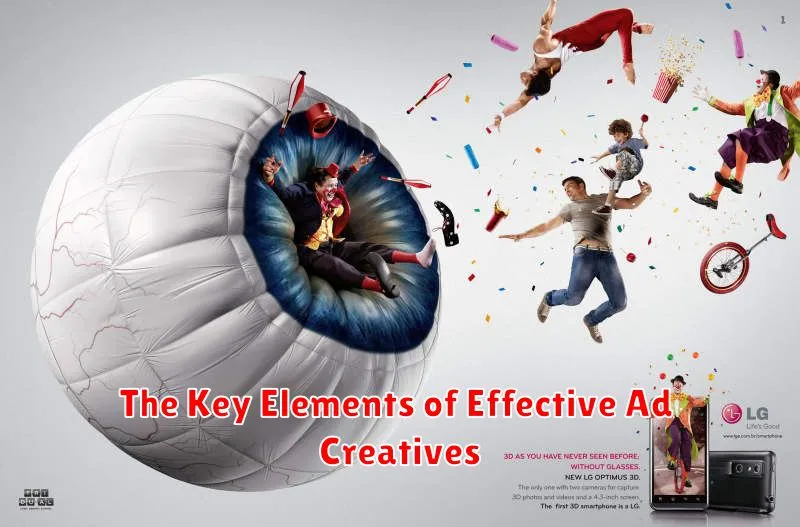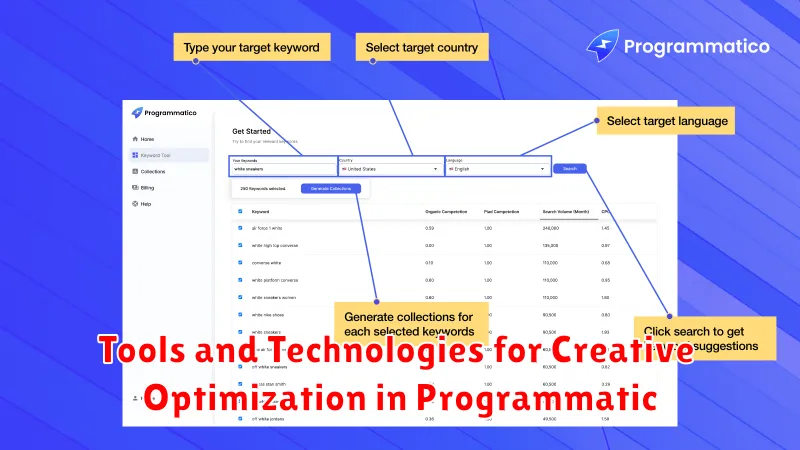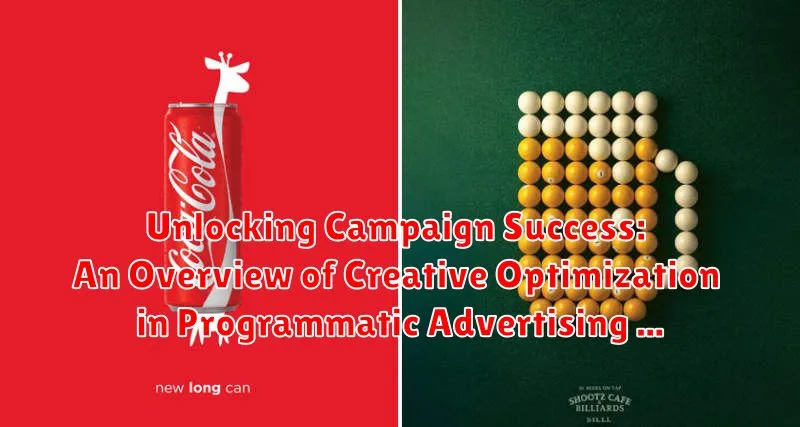In today’s fiercely competitive digital advertising landscape, achieving campaign success hinges not just on strategic targeting, but also on the dynamic process of creative optimization. This article delves into the critical role that creative optimization plays within programmatic advertising, exploring how data-driven insights and iterative improvements to ad creatives – including images, videos, and ad copy – are paramount for maximizing return on investment (ROI) and driving meaningful engagement with target audiences globally. Understanding and implementing effective creative optimization techniques is no longer optional; it’s a fundamental requirement for brands seeking to thrive in the ever-evolving digital sphere.
This overview of creative optimization in programmatic advertising will provide a comprehensive understanding of key strategies and best practices. We’ll explore how analyzing performance metrics, A/B testing different creative elements, and leveraging real-time feedback can lead to significant improvements in campaign performance. From defining clear objectives and selecting the right measurement tools to implementing advanced strategies like dynamic creative optimization (DCO), this article aims to equip marketers with the knowledge necessary to unlock campaign success and drive impactful results across their programmatic initiatives.
What is Creative Optimization and Why is it Important?
Creative optimization is the systematic process of enhancing ad creatives to improve their performance, ultimately leading to better campaign results. It involves analyzing data, testing variations, and refining ad elements to resonate more effectively with the target audience. This includes continually tweaking visuals, messaging, and calls-to-action.
The importance of creative optimization stems from its direct impact on key metrics. For example:
- Improved Click-Through Rates (CTR): More engaging creatives entice users to click, driving traffic to landing pages.
- Increased Conversion Rates: Relevant and compelling ad messages can lead to higher conversion rates, whether that’s sales, leads, or other desired actions.
- Enhanced Return on Ad Spend (ROAS): By maximizing the effectiveness of ad spend, creative optimization contributes to a greater return on investment.
- Better Brand Perception: Creatives that are well-designed and aligned with brand values can improve brand perception and recognition.
In the competitive landscape of programmatic advertising, creative optimization is no longer optional. It’s a critical necessity for achieving campaign goals and maximizing the value of every ad dollar.
The Key Elements of Effective Ad Creatives

Effective ad creatives are crucial for captivating the target audience and driving desired actions within programmatic advertising campaigns. Several key elements contribute to a compelling and high-performing ad creative.
Visual Appeal: High-quality imagery or video is paramount. Visuals should be relevant to the brand and message, and optimized for the various platforms and ad formats. Consider the use of color, composition, and overall aesthetic to grab attention.
Concise Messaging: The ad copy should be clear, concise, and persuasive. Highlight the key benefits of the product or service and use a strong call to action.
Brand Consistency: Maintain brand consistency across all ad creatives. Use the brand’s logo, colors, and typography to reinforce brand recognition and build trust.
Relevance: Ensure the ad creative is relevant to the target audience and the context in which it is displayed. Tailor the message and visuals to resonate with the specific interests and needs of the user.
Call to Action (CTA): A clear and compelling call to action is essential for guiding users towards the desired action, such as visiting a website, making a purchase, or filling out a form.
A/B Testing and Multivariate Testing for Creative Improvement
A/B testing and multivariate testing are essential methodologies for enhancing ad creatives. A/B testing, also known as split testing, compares two versions of an ad element (e.g., headline, image, call-to-action) to determine which performs better. This involves splitting your audience and showing each group a different version, then measuring the resulting metrics.
Multivariate testing, on the other hand, tests multiple elements simultaneously. Instead of comparing just two versions, it tests different combinations of multiple elements (e.g., headline, image, button color) to identify the most effective combination. This approach is more complex but can reveal more nuanced insights.
By implementing A/B and multivariate testing, advertisers can systematically refine their creatives, optimize for specific metrics, and drive improved campaign performance. These methodologies offer a data-driven approach to creative improvement, ensuring that ad design and messaging are aligned with audience preferences and campaign objectives.
Data-Driven Insights for Optimizing Ad Design and Messaging
In the realm of programmatic advertising, data-driven insights are paramount for optimizing ad design and messaging. By meticulously analyzing campaign data, advertisers can gain a deeper understanding of audience preferences and behaviors.
Harnessing Data Sources
Several key data sources inform effective creative optimization:
- Click-Through Rates (CTR): Analyze which ad elements drive higher engagement.
- Conversion Rates: Identify the creative attributes that lead to desired actions.
- Viewability Metrics: Ensure ads are seen by the intended audience.
- Demographic Data: Tailor messaging based on age, gender, location, and interests.
- Website Analytics: Understand how users interact with the brand’s website after seeing an ad.
Applying Insights to Creative Decisions
These data points enable informed decisions about:
- Visual Elements: Choice of images, videos, and colors.
- Ad Copy: Tone, length, and call-to-action.
- Placement: Where the ad is displayed.
- Targeting: Which audiences see the ad.
Personalization and Dynamic Creative Optimization (DCO)
Personalization in programmatic advertising involves tailoring ad creatives to individual users based on their unique characteristics, behaviors, and preferences. This enhances relevance and engagement.
Dynamic Creative Optimization (DCO) takes personalization a step further by automatically generating and serving ad variations in real-time based on data insights. This automated process ensures the most effective creative is shown to each user.
DCO leverages data points such as:
- Demographics
- Browsing History
- Purchase Behavior
- Location
By utilizing personalization and DCO, advertisers can significantly improve click-through rates (CTR), conversion rates, and overall return on ad spend (ROAS). It shifts from a one-size-fits-all approach to a tailored experience.
How to use creative automation
Creative automation leverages technology to streamline the ad creation process, enabling marketers to produce high volumes of personalized ad variations efficiently. To effectively utilize creative automation, consider the following steps:
- Define Clear Objectives: Establish specific goals for your campaigns, such as increasing click-through rates (CTR) or conversions.
- Select a Suitable Platform: Choose a creative automation platform that aligns with your needs and programmatic advertising ecosystem.
- Establish your Brand Guidelines: It will dictate the visual standard used in the creative.
- Develop Ad Templates: Create modular templates with customizable elements like headlines, images, and call-to-actions.
- Integrate Data Feeds: Connect your data sources (e.g., product catalogs, customer data) to populate ad templates dynamically.
- Set up Rules and Logic: Define rules that trigger specific ad variations based on audience segments, context, or real-time data.
- Monitor and Optimize: Continuously track performance metrics and refine your automation rules and templates to maximize effectiveness.
By automating repetitive tasks and leveraging data-driven insights, creative automation empowers marketers to deliver more relevant and engaging ad experiences at scale.
Creative Fatigue and Refresh Strategies
Creative fatigue occurs when audiences become overexposed to the same ad creatives, leading to decreased engagement and diminished campaign performance. Recognizing and addressing creative fatigue is crucial for maintaining the effectiveness of programmatic advertising efforts.
To combat creative fatigue, implement refresh strategies that involve regularly updating and diversifying ad creatives. This can include:
- Introducing new visuals: Experiment with different images, videos, and animations to capture attention.
- Modifying ad copy: Update headlines, descriptions, and calls to action to maintain relevance and intrigue.
- Varying ad formats: Test different ad sizes and formats to see which resonate best with the target audience.
- Adjusting targeting parameters: Refine audience targeting to ensure ads are reaching the most receptive users.
By proactively refreshing ad creatives, advertisers can avoid creative fatigue and ensure that their campaigns continue to deliver optimal results.
Measuring the Impact of Creative Optimization on Campaign Performance
To effectively gauge the success of creative optimization efforts, it is imperative to establish clear Key Performance Indicators (KPIs) prior to campaign launch. These KPIs should align with overall marketing objectives and may include metrics such as Click-Through Rate (CTR), Conversion Rate, Cost Per Acquisition (CPA), and Return on Ad Spend (ROAS).
Regular monitoring and analysis of these metrics are crucial. Compare performance data of optimized creatives against baseline creatives to quantify the incremental lift achieved through optimization strategies. Statistical significance testing can validate the impact of changes.
Furthermore, attribution modeling plays a vital role in understanding the customer journey and how different creative iterations contribute to conversions. By analyzing attribution data, marketers can gain insights into which creative elements are most effective at driving desired outcomes.
Tools and Technologies for Creative Optimization in Programmatic

Creative optimization in programmatic advertising relies heavily on a suite of sophisticated tools and technologies. These resources empower marketers to refine their ad creatives and maximize campaign effectiveness.
Key Categories of Tools
Several categories of tools are critical to the creative optimization process:
- Dynamic Creative Optimization (DCO) Platforms: These platforms enable the creation of personalized ad experiences by dynamically altering creative elements based on user data.
- A/B Testing Platforms: These tools facilitate controlled experiments to determine which ad variations perform best.
- Data Analytics Platforms: These platforms provide insights into campaign performance, user behavior, and creative effectiveness.
- Creative Management Platforms (CMP): These platforms streamline the creative workflow, from asset management to version control.
Examples of Technologies
Technologies such as machine learning and artificial intelligence (AI) are increasingly integrated into these tools to automate optimization processes and identify high-performing creative combinations. These technologies can analyze vast amounts of data and provide actionable recommendations for improving ad creatives.
Best Practices for Continuous Creative Improvement
Continuous creative improvement is vital for sustaining the effectiveness of programmatic advertising campaigns. It involves a systematic approach to refining ad creatives based on performance data and evolving audience insights.
Here are some best practices:
- Establish a Feedback Loop: Regularly monitor campaign performance and gather data on key metrics such as click-through rates (CTR), conversion rates, and cost per acquisition (CPA).
- Iterative Testing: Implement A/B testing and multivariate testing to identify which creative elements resonate most with your target audience.
- Analyze Performance Data: Scrutinize performance reports to identify trends, patterns, and areas for improvement. Use these insights to inform future creative iterations.
- Stay Updated with Industry Trends: Keep abreast of the latest design trends, advertising technologies, and audience behaviors.
- Document and Share Learnings: Maintain a record of all creative tests, results, and key learnings. Share these findings with your team to foster a culture of continuous improvement.

